-
If you are posting pictures, and they aren't posting in the correct orientation, please flush your browser cache and try again.
Edge
Safari/iOS
Chrome
You are using an out of date browser. It may not display this or other websites correctly.
You should upgrade or use an alternative browser.
You should upgrade or use an alternative browser.
6-8’ Walmart Dunstan Chestnut
- Thread starter Troubles Trees
- Start date
-
- Tags
- jebadiah
Very interesting. My best performers get mostly morning sun and are mostly shaded from direct afternoon sun.
right off the good ol "net" ....
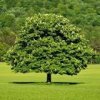
"Soil Conditions & Light Exposure for the Dunstan Chestnut Tree. Dunstan Chestnut trees prefer well-drained, slightly acidic soil. A soil pH of 4.5 to 6.0 is best. ... For optimal nut production, these trees should be planted in a place with full-sun exposure. (emphasis added) Soil Condition: Any well drained soil. Uses: Tolerates moist soil and full sun.
Water Requirements: Water well until establish... Growing Zone: 6-9"
Full sun .... it's what works for me. I have some in areas with reduced hours of sunlight and they grow slower and are less robust (often spindly in structure).
Hey, if it works for you ..... do it!
Troubles Trees
5 year old buck +
The 5 2 year olds I got at lowes last year down in Texas receive 10 hours of sun per day + now 100 degree temp for 5 days in a row now. They keep on kicking.
I have no problem buying trees from the big box stores, I know some on here aren't a fan because it is a mystery what rootstock was used, but they are huge trees for the price and handle planting shock so much better than bareroot seedlings. I bought 5 White Oak, 5 Keiffer pears and 5 mixed name apple trees from Lowes last year after they discounted them at the end of season. All 15 trees have a ton of new growth on them with new branches and added roughly 2-3 feet of height this year and didn't seem to have any shock at all regarding transplanting. Maybe my soil just sucks but that would be evident in both mature trees and seedlings I would think.
The first year I owned the property next door (4 planting seasons so far) I planted 480 seedlings of all kinds, trees, shrubs and berry bushes from our DEC seedling sale. Most of them are only knee high today, all are supposed to be native to NY like Beach Plumb, Serviceberry, Highbush Cranberry, Oak brush, Elderberry.. too many to list but my point is I have babied them as best as I can and they aren't gaining much mass each year. The same year I also planted bare root Chinese Chestnuts and Persimmons from a reputable nursery, 3.5 growing seasons later they are between 3-5 feet tall and I used tree tubes, weed matting and mulch on each of them, so to expect nuts and fruit I would imagine it will be at least 10 years minimal anyway. To see a burr on a Chestnut in the store, and to know they came from Chestnut Hill at least feels like progress and some sort of payout sooner than later, at least sooner than the Chinese Chestnuts I planted 3 years prior. Don't get me wrong, I understand things take time to grow and start producing, I can be patient, but these kind of trees give me a head start on nut production. I do not expect burrs on these Chestnuts next year, I don't even expect high output of nuts for 8-10 years. I am running out of room to plant so I can afford to pay a little more for a much larger tree.
Troubles Trees
5 year old buck +
right off the good ol "net" ....
View attachment 30637
"Soil Conditions & Light Exposure for the Dunstan Chestnut Tree. Dunstan Chestnut trees prefer well-drained, slightly acidic soil. A soil pH of 4.5 to 6.0 is best. ... For optimal nut production, these trees should be planted in a place with full-sun exposure. (emphasis added) Soil Condition: Any well drained soil. Uses: Tolerates moist soil and full sun.
Water Requirements: Water well until establish... Growing Zone: 6-9"
Full sun .... it's what works for me. I have some in areas with reduced hours of sunlight and they grow slower and are less robust (often spindly in structure).
Hey, if it works for you ..... do it!
Solid info bud, thank you sir!!
yoderjac
5 year old buck +
right off the good ol "net" ....
View attachment 30637
"Soil Conditions & Light Exposure for the Dunstan Chestnut Tree. Dunstan Chestnut trees prefer well-drained, slightly acidic soil. A soil pH of 4.5 to 6.0 is best. ... For optimal nut production, these trees should be planted in a place with full-sun exposure. (emphasis added) Soil Condition: Any well drained soil. Uses: Tolerates moist soil and full sun.
Water Requirements: Water well until establish... Growing Zone: 6-9"
Full sun .... it's what works for me. I have some in areas with reduced hours of sunlight and they grow slower and are less robust (often spindly in structure).
Hey, if it works for you ..... do it!
I've seen that info from Chestnut Hill. I'm not sure it completely coincides with my experience. "optimal nut production" probably means maximizing nut production from mature trees. That may be true, once trees reach maturity. By then, they can handle a lot more. I think full sun stresses my seedlings when they are young. It may be a climate particular thing. I'm not sure. It could be their context is an orchard where trees are watered, verses a wildlife tree. My best trees have only been producing nuts for a few years and those that are partially shaded from the hot afternoon sun are both growing and producing the best so far. Perhaps after trees survive to maturity, those in full sun will catch up and/or overtake the others.
I'm providing my personal experience so far with Dunstan chestnut seedlings. While most of the quote seems to be generally true, I don't give it much weight coming from Chestnut Hill. There estimates for time to nut production and the estimated amount of nuts are extremely aggressive in my opinion. Sure, I'm sure there are some Dunstan seedlings somewhere that met those production goals, but not close to what to expect from your average tree.
Thanks,
Jack
The Fishman
5 year old buck +
There estimates for time to nut production and the estimated amount of nuts are extremely aggressive in my opinion. Sure, I'm sure there are some Dunstan seedlings somewhere that met those production goals, but not close to what to expect from your average tree.
I also agree that their 3-5 year estimate to produce nuts is too optimistic. I have bought 3-gallon trees from Walmart that were producing nuts when I bought them. Even after a couple of years in the ground they have not produced another nut. I am okay with that as I view them as a long-term investment. I would rather a larger payoff later than a short-term gain now. I want them to put energy into developing roots and not producing a few nuts each year that will not be more than a quick snack for wildlife. I have seen so many people comment on how their 5-year-old trees aren't producing. They bought into the hype of getting tons of nuts quickly and it just isn't going to happen in most cases.
yoderjac
5 year old buck +
I also agree that their 3-5 year estimate to produce nuts is too optimistic. I have bought 3-gallon trees from Walmart that were producing nuts when I bought them. Even after a couple of years in the ground they have not produced another nut. I am okay with that as I view them as a long-term investment. I would rather a larger payoff later than a short-term gain now. I want them to put energy into developing roots and not producing a few nuts each year that will not be more than a quick snack for wildlife. I have seen so many people comment on how their 5-year-old trees aren't producing. They bought into the hype of getting tons of nuts quickly and it just isn't going to happen in most cases.
Years ago, I planted some bare root Tigertooth Jujube trees as an experiment based on an article David Osborn wrote for Quality Whitetails. That variety is supposed to be self-fruitful. The trees grew well (except for one that got some gly drift). They got bigger and bigger and older and older, but still no fruit. I was beginning to suspect that they were not really self-fruitful or the Jujube trees I was sold were actually another variety that required a different variety as a pollinator.
Meanwhile, I was experimenting with propagation. I took some root cuttings from these Jujube trees, hit them with rooting hormone and put them in some sand. I gave up on them after a couple months, but one day, quite a bit later, I noticed something growing out of that sand. First one, then another, and so on. I got several clones of one of the trees. Most Jujube are grafted onto wild jujube root stock, but these Tigertooth were grown on their own roots, so these were clones of the tree I took the root cuttings from. As the grew, I transplanted them to 1 gal Rootbuilder II containers. By that fall, I got a couple tigertooth fruit on these clones that were less than a year old, yet the 15' parent tree had not produced any fruit.
I emailed both David Osborn and eventually got connected with a university professor who was an expert on jujube. The professor judged that my trees in the field were not mature enough to produce fruit. They were still in a vegetative growth state. He believed that the container constricting the root system caused the tree to move from a vegetative state to a fruit production state. He said this is not unique to jujube and happens to other trees grown in containers. He suggested that as soon as I planted the young clone in the field, it would revert to a vegetative state and stop producing fruit.
He was absolutely correct on all accounts. Several years later, my jujube trees in the field started producing and production got heavier each year. When the clone was planted in the field, I stopped producing fruit.
I believe when you see nuts on the walmart Dunstan trees, it is exactly this phenomenon and it is what you experienced.
I completely agree, that adding mast trees is a long term project and there is no real short-cuts. There are things we can do to maximize chances of success, but it is all pretty long term. My quickest production comes from native persimmon trees that I cut down and bark graft with female scions from mature trees. It is not uncommon for them to produce persimmons in the third leaf, but it still takes quite a few more years before the production becomes substantial.
Thanks,
Jack
Troubles Trees
5 year old buck +
These are the Red Oaks I planted last spring from Lowe’s :) At the time of purchase both of these were about 7 foot tall trees, today they are 10 and 12 feet tall.
It’s certainly not going to produce enough acorns to draw deer for about 10 years but it will be productive long before my seedlings I planted a year earlier will.


It’s certainly not going to produce enough acorns to draw deer for about 10 years but it will be productive long before my seedlings I planted a year earlier will.


Last edited:
blueKYstream
5 year old buck +
I bought a few varieties (persimmon, mulberry, and chestnuts) from Chestnut Hill Outdoors at Walmart and planted them near the same time as I planted some bareroot seedlings. About 3.5 years in, I see no difference in size. The persimmon and mulberries were mislabeled. It happens, but I've reached out to them on Instagram, Facebook, and about a half dozen times through email. I have never gotten a response. I won't buy from them again.
Angus 1895
5 year old buck +
I started 50 dunstan seeds from eBay from a PA. Address.
I had almost 100% germination but I was struck with dampening disease. Too wet too cold too much clay in the soil mix.
Hands down the styrofoam cups were better than the plastic. But the styrofoam gets brittle exposed to sun.
I use sulfur and ironite to lower soil ph when I plant them. I used ironite top dress in the pots/ potting mix.
The container crab apples have done better than the pin oaks.
It is my belief that a tap root is a valuable asset to growth in my trees that normally have a tap root.
I set up my nursery to get filtered afternoon sun but full morning sun.
I found the fiber pots do not degrade or rot fast enough for my taste and will not use them again.
You can see how brown the land is around, we have had another dry year.
I had almost 100% germination but I was struck with dampening disease. Too wet too cold too much clay in the soil mix.
Hands down the styrofoam cups were better than the plastic. But the styrofoam gets brittle exposed to sun.
I use sulfur and ironite to lower soil ph when I plant them. I used ironite top dress in the pots/ potting mix.
The container crab apples have done better than the pin oaks.
It is my belief that a tap root is a valuable asset to growth in my trees that normally have a tap root.
I set up my nursery to get filtered afternoon sun but full morning sun.
I found the fiber pots do not degrade or rot fast enough for my taste and will not use them again.
You can see how brown the land is around, we have had another dry year.
Attachments
-
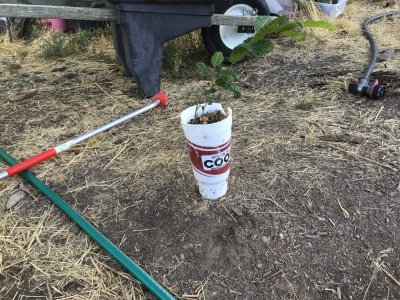 189E577D-4939-428F-85EA-B63F2B35232F.jpeg767.1 KB · Views: 6
189E577D-4939-428F-85EA-B63F2B35232F.jpeg767.1 KB · Views: 6 -
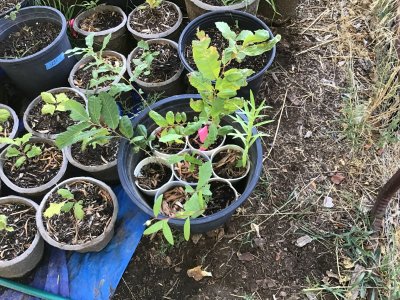 E406EEF9-DB45-4891-832F-35E623E0F8E1.jpeg696.9 KB · Views: 6
E406EEF9-DB45-4891-832F-35E623E0F8E1.jpeg696.9 KB · Views: 6 -
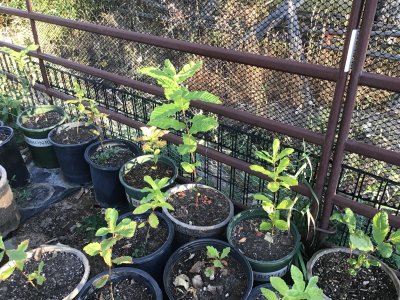 57ED82BC-6078-4FF7-9CD1-82EC0A640D1B.jpeg684.4 KB · Views: 8
57ED82BC-6078-4FF7-9CD1-82EC0A640D1B.jpeg684.4 KB · Views: 8 -
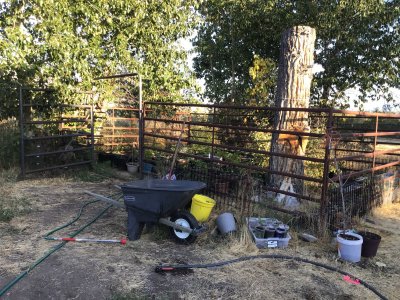 F0838A48-D4DE-482E-A5A9-8A6C48C0C8F4.jpeg736.5 KB · Views: 7
F0838A48-D4DE-482E-A5A9-8A6C48C0C8F4.jpeg736.5 KB · Views: 7 -
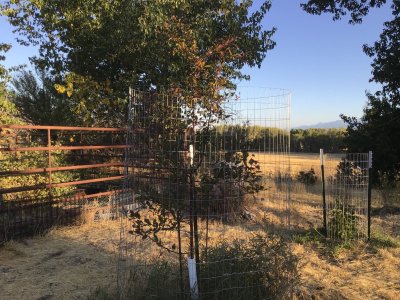 477D7C8E-E259-48FD-8ABA-C2CCCB935D2D.jpeg649.2 KB · Views: 7
477D7C8E-E259-48FD-8ABA-C2CCCB935D2D.jpeg649.2 KB · Views: 7 -
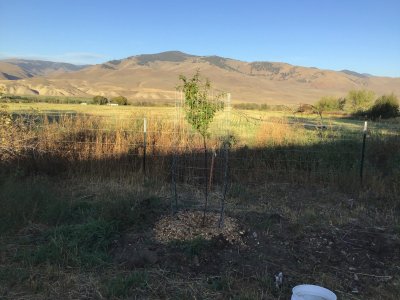 72ECFD93-C0D4-4CB6-A26F-541C14B30DCA.jpeg406.3 KB · Views: 6
72ECFD93-C0D4-4CB6-A26F-541C14B30DCA.jpeg406.3 KB · Views: 6 -
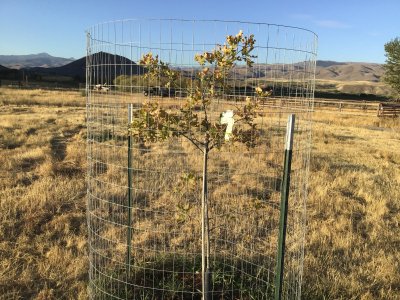 73D0A0A8-A216-40F6-8BBB-A6DA73FF7DFC.jpeg690.9 KB · Views: 7
73D0A0A8-A216-40F6-8BBB-A6DA73FF7DFC.jpeg690.9 KB · Views: 7 -
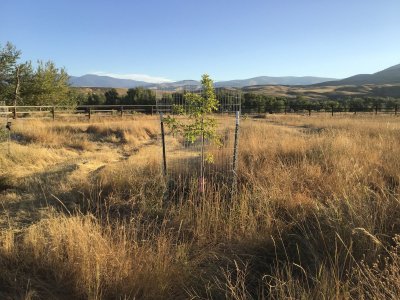 18F46B14-3D43-4FD2-BD65-D3C408C733AA.jpeg543.6 KB · Views: 6
18F46B14-3D43-4FD2-BD65-D3C408C733AA.jpeg543.6 KB · Views: 6
Similar threads
- Replies
- 39
- Views
- 5K
- Replies
- 5
- Views
- 3K
